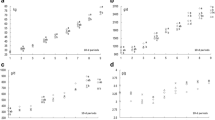Abstract
While legumes are regarded as good sources of protein they are poorly digested so improved digestibility would be a desirable objective in a breeding programme. From the point of view of protein quality they are limited by the sulphur amino acids (SAA) so an increase in these is a primary nutritional objective of a breeding programme and their lysine content is regarded as being of secondary importance. However, some traditional methods of preparation are far more severe than that necessary to cook the food and may result in loss of lysine. These two problems are being investigated.
(1) True digestibility of the nitrogen (TD-N) of cooked, white haricot beans (Phaseolus vulgaris) was measured by feeding to rats at 20, 40 and 80% levels in the diet (5, 10 and 20% protein), for 10 days periods when 23 days old and again when 63 days old.
TD-N at the three dietary levels was 80, 74 and 67% for the young animals and 63, 55 and 51% when more mature.
True digestibility of dry matter (TD-DM) was very much higher at 97, 92 and 83% for younger and 95, 90 and 81% for older animals.
The considerable difference between TD-N and TD-DM together with the apparently greater TD-N by the younger rats suggests that the extra faecal N does not come from the undigested food but possibly from residues of digestive juices. Results suggest that it is necessary to standardise the conditions for measuring TD.
Five legumes were boiled for 2 h and 8 h; available lysine fell by 5–10% after 2 h and by 15–20% after 8 h. Improvement in flavour appeared to parallel development of the Maillard reaction and loss of available lysine. SAA were still limiting so that NPU does not reveal loss of available lysine. However, in diets where legumes are used to supplement cereals in such proportions that lysine is limiting this loss may become of nutritional importance.
Zusammenfassung
Da die Leguminosen als eine gute Eiweißquelle angesehen werden, aber schwer verdaulich sind, ist die Verbesserung der Verdaulichkeit ein wünschenswertes Züchtungsziel. Vom Gesichtspunkt der Proteinqualität her, sind die schwerfolhaltigen Aminosäuren (SAA) die limitierenden Faktoren, so daß eine Steigerung ihres Gehaltes Hauptanliegen des Züchtungsprogrammes ist, der Lysin-Gehalt is erst in zweiter Linie von Bedeutung. Einige der traditionellen Zubereitungsarten sind jedoch weitaus drastischer als zum Kochen erforderlich und können zu Lysin-Verlusten führen. Diese beiden Probleme wurden untersucht.
Der wahre Ausnutzungs-Quotient an Trockensubstanz (true digestibility of dry N) von gekochten, weißen Phaseolus Vulgaris-Bohnen wurde in Ratten-Fütterungsversuchen mit Anteilen von 20, 40 und 80% in den Rationen (entspr. 5, 10 und 20% Protein) bestimmt, während zehntägiger Perioden einmal im Alter von 23 Tagen und erneut im Alter von 63 Tagen.
TD-N betrug bei den drei Rationen 80, 74 und 67% bei den jungen Tieren und 63, 55 und 51% bei den älteren.
Der wahre Ausnutzungs-Quotient an Trockensubstanz (true digestibility of dry matter=TD-DM) war weitaus höher mit 97, 92 und 83% bei den jungen und mit 95, 90 und 81% bei den älteren Tieren.
Der beträchtliche Unterschied zwischen TD-N und TD-DM verbunden mit dem scheinbar höheren TD-N bei den jüngeren Ratten läßt vermuten, daß der Extra-Fäkal-N nicht von der unverdauten Nahrung stammt, sondern möglicherweise von Resten von Verdauungssäften. Die Ergebnisse weisen auf die Notwendigkeit einer Standardisierung der TD-Bestimmungen hin.
Fünf Leguminosen-Arten wurden 2 und 8 Stunden gekocht, der verfügbare Lysin-Gehalt fält um 5–10% nach 2 und um 15–25% nach 8 Stunden. Verbesserung des Geschmacks (Flavour) scheint parallel einherzugehen mit Fortschreiten der Maillard-Reaktion und Verlust des verfügbaren Lysins. Der gehalt an schwefelhaltigen Aminosäuren (SAA) war immer noch limitierend, so daß NPU nicht auf den Verlust an verfügbaren Lysin hinweist.
In einer Nahrung jedenfalls, in der Leguminosen durch Cerealien in solchen Proportionen ergänzt werden, in denen Lysin den limitierenden Faktor darstellt, mag dieser Verlust von ernährungsphysiologischer Bedeutung sein.
Similar content being viewed by others
References
Bender, A. E. Husaini 1976.J. Fd. Technol. 11:499–503.
Bressani, R. & Elias, L.G. 1977. In Hulse et al. (1977).
Hulse, J.H., Rachie, K.O. & Billingsley, W. (1977) Nutritional standards and methods of evaluation for food legumes. International Development Research Centre IDRC-TS7e. Ottawa, Canada
Hurrell, R.F. & Carpenter, K.J. (1975).Proc. Nutr. Soc. 3525A.
Jaffe, W.G. & Carpenter, M.E. (1975).Arch. Latinoam. Nutr. (Venezuela) 25:79
Author information
Authors and Affiliations
Rights and permissions
About this article
Cite this article
Bender, A.E., Mohammadiha, H. & Almas, K. Digestibility of legumes and available lysine content. Plant Food Hum Nutr 29, 219–226 (1979). https://doi.org/10.1007/BF02590276
Issue Date:
DOI: https://doi.org/10.1007/BF02590276




